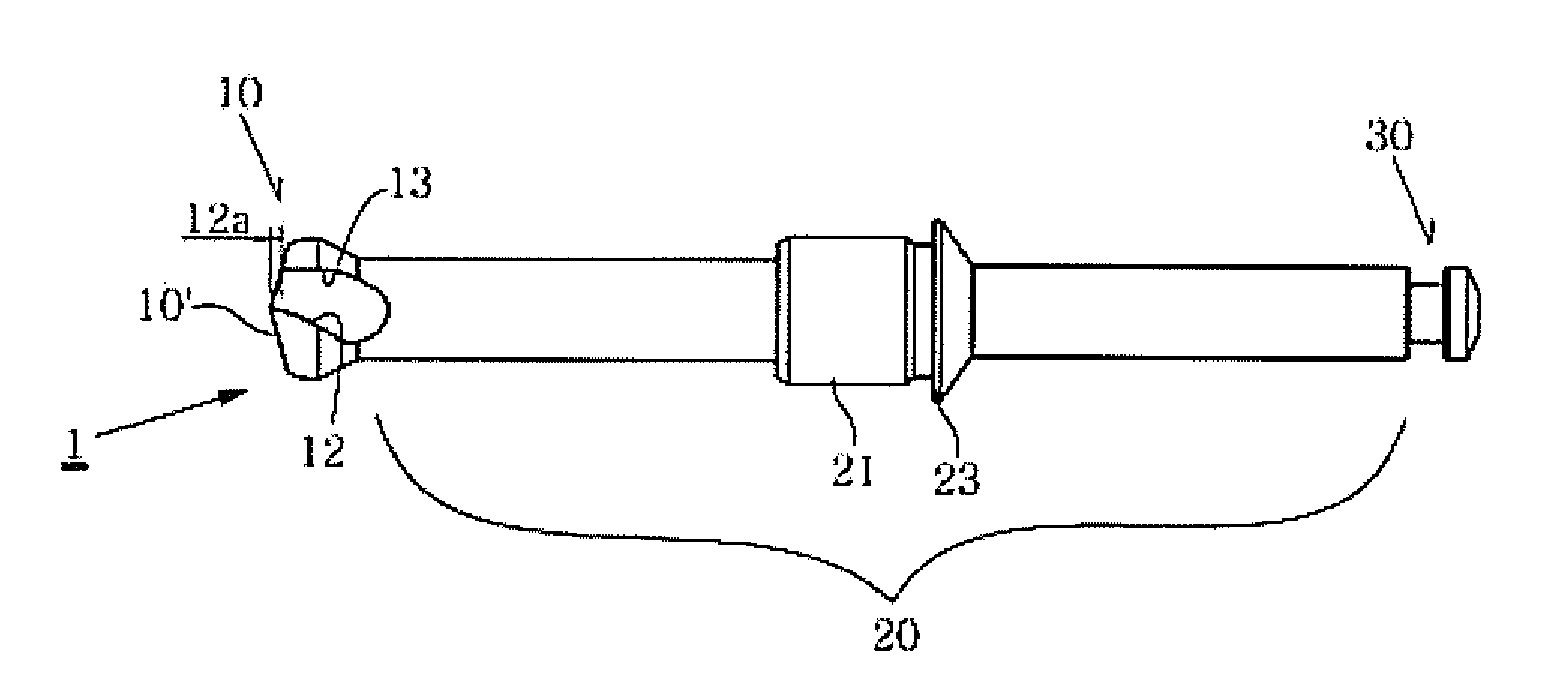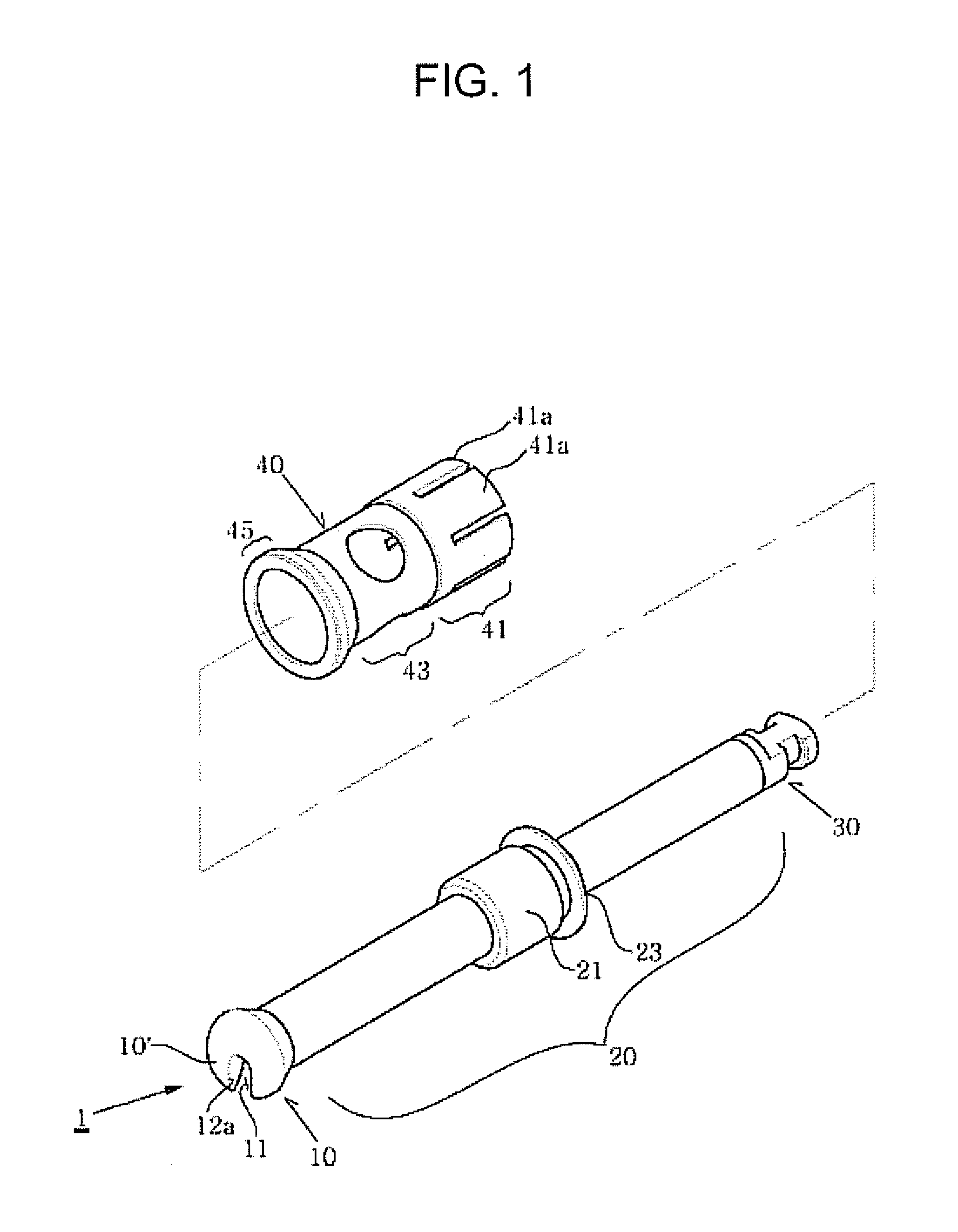Drill for sinus membrane lift
- Summary
- Abstract
- Description
- Claims
- Application Information
AI Technical Summary
Benefits of technology
Problems solved by technology
Method used
Image
Examples
first embodiment
[0062]The drill for sinus membrane lift 1 of this embodiment has a similar construction to that of the first embodiment as described above. Herein, the same components will be designated with the same reference numerals and will not be described in detail.
[0063]As shown in the drawings, characteristic features of this embodiment are that the first inside wall 12 and the second inside wall 13 are directly connected to each other unlike in the first embodiment. Specifically, the first and second inside walls 12 and 13 run parallel to each other and then are connected to each other at an acute angle.
[0064]FIGS. 13 to 18 illustrate a drill for sinus membrane lift according to a third embodiment of the present invention, which is designed to maintain bone fragments as well as minimize any perforation of the membrane. In these drawings, FIG. 13 is a perspective view illustrating the first embodiment, FIG. 14 is a plan view of FIG. 13 as viewed from above, FIG. 15 is a front elevational vi...
second embodiment
[0072]The drill for sinus membrane lift 1 of this embodiment has a similar construction to that of the second embodiment as described above. Herein, the same components will be designated with the same reference numerals and will not be described in detail.
[0073]As shown in the drawings, this embodiment proposes two bone-maintaining areas 11 as characteristic features, which are spaced apart from each other with a uniform interval.
[0074]In the bone-maintaining areas 11, the first inside wall 12 and the second inside wall 13 are arranged opposite each other and are connected to each other at an acute angle.
[0075]Further, in a pair of the bone-maintaining areas 11, one of the two bone-maintaining areas can preferably include an axis so as to effectively drill the maxilla.
[0076]FIGS. 31 to 36 illustrate a drill for sinus membrane lift according to a sixth embodiment of the present invention, in which FIG. 31 is a perspective view illustrating the first embodiment, FIG. 32 is a plan vie...
third embodiment
[0077]The drill for sinus membrane lift 1 of this embodiment has a similar construction to that of the third embodiment as described above. Herein, the same components will be designated with the same reference numerals and will not be described in detail.
[0078]While the drill for sinus membrane lift 1 as the characteristic feature of this embodiment is similar to that of the third embodiment, this embodiment proposes two bone-maintaining areas 11 to be spaced apart from each other by a uniform interval as shown in the drawings.
[0079]The respective bone-maintaining areas 11 are provided in the form of through holes, and one of the bone-maintaining areas 11 can preferably include an axis so as to allow uniform and effective drilling of the maxilla.
PUM
 Login to View More
Login to View More Abstract
Description
Claims
Application Information
 Login to View More
Login to View More - R&D Engineer
- R&D Manager
- IP Professional
- Industry Leading Data Capabilities
- Powerful AI technology
- Patent DNA Extraction
Browse by: Latest US Patents, China's latest patents, Technical Efficacy Thesaurus, Application Domain, Technology Topic, Popular Technical Reports.
© 2024 PatSnap. All rights reserved.Legal|Privacy policy|Modern Slavery Act Transparency Statement|Sitemap|About US| Contact US: help@patsnap.com










